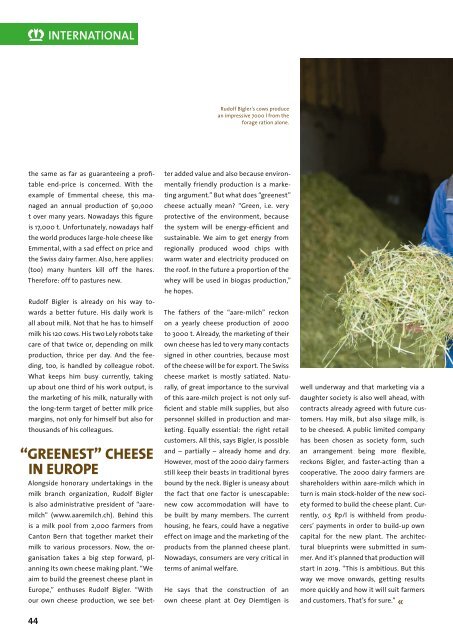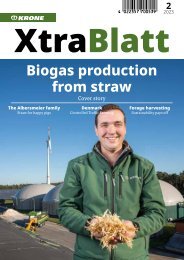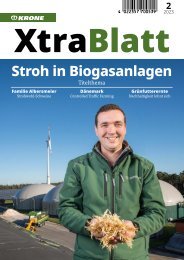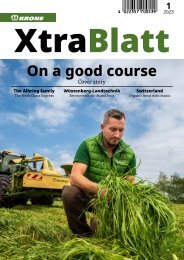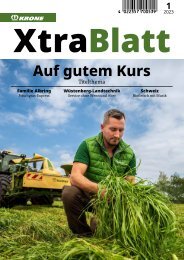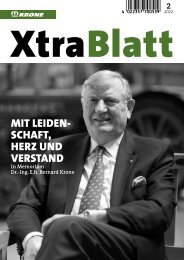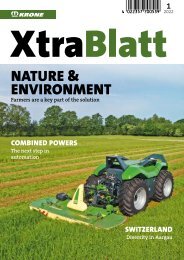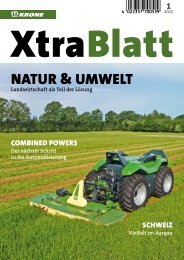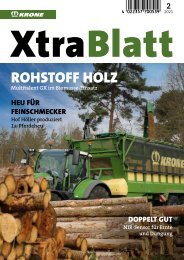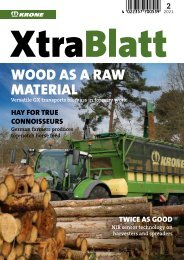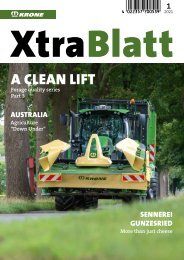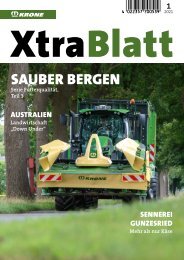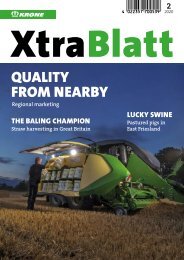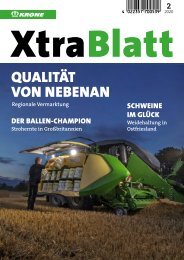XtraBlatt Issue 02-2017
Create successful ePaper yourself
Turn your PDF publications into a flip-book with our unique Google optimized e-Paper software.
MENSCHEN INTERNATIONAL<br />
Rudolf Bigler’s cows produce<br />
an impressive 7000 l from the<br />
forage ration alone.<br />
the same as far as guaranteeing a profitable<br />
end-price is concerned. With the<br />
example of Emmental cheese, this managed<br />
an annual production of 50,000<br />
t over many years. Nowadays this figure<br />
is 17,000 t. Unfortunately, nowadays half<br />
the world produces large-hole cheese like<br />
Emmental, with a sad effect on price and<br />
the Swiss dairy farmer. Also, here applies:<br />
(too) many hunters kill off the hares.<br />
Therefore: off to pastures new.<br />
Rudolf Bigler is already on his way towards<br />
a better future. His daily work is<br />
all about milk. Not that he has to himself<br />
milk his 120 cows. His two Lely robots take<br />
care of that twice or, depending on milk<br />
production, thrice per day. And the feeding,<br />
too, is handled by colleague robot.<br />
What keeps him busy currently, taking<br />
up about one third of his work output, is<br />
the marketing of his milk, naturally with<br />
the long-term target of better milk price<br />
margins, not only for himself but also for<br />
thousands of his colleagues.<br />
“GREENEST” CHEESE<br />
IN EUROPE<br />
44<br />
Alongside honorary undertakings in the<br />
milk branch organization, Rudolf Bigler<br />
is also administrative president of “aaremilch”<br />
(www.aaremilch.ch). Behind this<br />
is a milk pool from 2,000 farmers from<br />
Canton Bern that together market their<br />
milk to various processors. Now, the organisation<br />
takes a big step forward, planning<br />
its own cheese making plant. “We<br />
aim to build the greenest cheese plant in<br />
Europe,” enthuses Rudolf Bigler. “With<br />
our own cheese production, we see better<br />
added value and also because environmentally<br />
friendly production is a marketing<br />
argument.” But what does “greenest”<br />
cheese actually mean? “Green, i.e. very<br />
protective of the environment, because<br />
the system will be energy-efficient and<br />
sustainable. We aim to get energy from<br />
regionally produced wood chips with<br />
warm water and electricity produced on<br />
the roof. In the future a proportion of the<br />
whey will be used in biogas production,”<br />
he hopes.<br />
The fathers of the “aare-milch” reckon<br />
on a yearly cheese production of 2000<br />
to 3000 t. Already, the marketing of their<br />
own cheese has led to very many contacts<br />
signed in other countries, because most<br />
of the cheese will be for export. The Swiss<br />
cheese market is mostly satiated. Naturally,<br />
of great importance to the survival<br />
of this aare-milch project is not only sufficient<br />
and stable milk supplies, but also<br />
personnel skilled in production and marketing.<br />
Equally essential: the right retail<br />
customers. All this, says Bigler, is possible<br />
and – partially – already home and dry.<br />
However, most of the 2000 dairy farmers<br />
still keep their beasts in traditional byres<br />
bound by the neck. Bigler is uneasy about<br />
the fact that one factor is unescapable:<br />
new cow accommodation will have to<br />
be built by many members. The current<br />
housing, he fears, could have a negative<br />
effect on image and the marketing of the<br />
products from the planned cheese plant.<br />
Nowadays, consumers are very critical in<br />
terms of animal welfare.<br />
He says that the construction of an<br />
own cheese plant at Oey Diemtigen is<br />
well underway and that marketing via a<br />
daughter society is also well ahead, with<br />
contracts already agreed with future customers.<br />
Hay milk, but also silage milk, is<br />
to be cheesed. A public limited company<br />
has been chosen as society form, such<br />
an arrangement being more flexible,<br />
reckons Bigler, and faster-acting than a<br />
cooperative. The 2000 dairy farmers are<br />
shareholders within aare-milch which in<br />
turn is main stock-holder of the new society<br />
formed to build the cheese plant. Currently,<br />
0.5 Rp/l is withheld from producers’<br />
payments in order to build-up own<br />
capital for the new plant. The architectural<br />
blueprints were submitted in summer.<br />
And it’s planned that production will<br />
start in 2019. “This is ambitious. But this<br />
way we move onwards, getting results<br />
more quickly and how it will suit farmers<br />
and customers. That’s for sure.”


